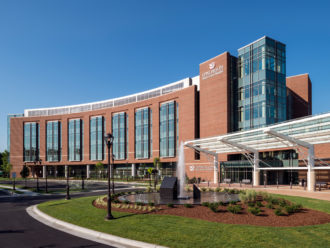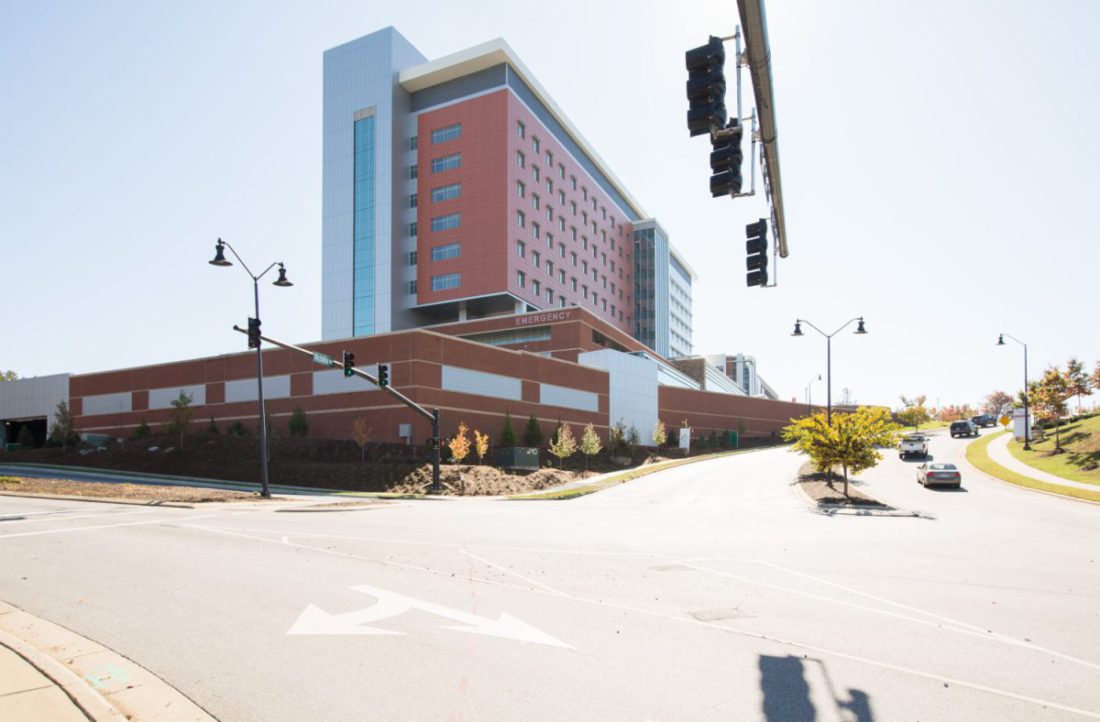By Christian Green, originally published by Carolina Public Press. Carolina Public Press is an independent, in-depth and investigative nonprofit news service for North Carolina.
“I’ve been dealing with COVID since we first received patients in March,” said Cameron Howard, an ICU nurse in a Triad area hospital. “As time goes along, I’m exhausted mentally — not physically, but mentally.”
“I’m exhausted,” she reiterated and then returned to the floor to care for a patient with COVID-19.
Howard’s experience reflects the unrelenting toll the pandemic has taken on what Dr. Mandy Cohen, N.C. Department of Health and Human Services secretary, called the state’s “most precious commodity” — people.
As coronavirus cases continue to climb in North Carolina, most of the state’s hospitals have the physical capacity to house more patients, but officials worry whether they have the staffing capacity to tend those beds.
“The biggest issue right now is not that hospitals are being filled up with patients; it is having enough staff to care for the people in the hospital,” said Dennis Taylor, president of the N.C. Nurses Association.
“We have enough beds, but do we have enough staff?”
North Carolina is home to an estimated 25,400 hospital beds, according to the North Carolina COVID-19 dashboard.
As of Nov. 24, 14,839 beds were in use, leaving about 11,000 open. Of those, roughly half were listed as “unreported or unstaffed,” meaning they were currently unavailable but could be created if a hospital were to implement a surge plan.
Roughly one-third of the state’s estimated 3,500 intensive care unit, or ICU, beds were listed as unreported or unstaffed.
“We know it is our ‘people resource’ that is really important to manage,” Cohen said at a recent press conference. “We need our doctors and our nurses to make sure that we can have not just a bed available, but we need to have it staffed by high-quality folks.”
Seven hospitals in North Carolina reported critical staffing shortages this week to the U.S. Department of Health and Human Services, and 10 hospitals, which may include the seven reporting this week, say they expect a staffing shortage next week.
Hospitalizations lag case count increases because many people do not seek hospital care until one to two weeks after they are diagnosed.
“These last two weeks we just keep seeing more and more patients,” ICU nurse Howard said. “We’re playing catch-up now.”
The delay means last week’s record high number of new cases won’t be fully experienced by hospitals until after Thanksgiving.
A problem that precedes the pandemic
Concerns about nursing shortages at North Carolina hospitals existed before the pandemic. “We’ve had staffing shortages in our state for at least the past five to 10 years,” Taylor said. “This is something we’ve seen coming.”
In 2002, after several other states had reported nursing shortages and employers in North Carolina reported difficulty filling open nursing positions, the N.C. Institute of Medicine formed the Task Force on the North Carolina Nursing Workforce.
“There are good reasons to believe that without some intervention, North Carolina will experience a shortage of registered nurses and other nursing assistive personnel over the next two decades,” the 2004 report stated.
According to UNC Chapel Hill’s Sheps Center for Health Services Research, as of 2019, 14 of the state’s 100 counties did not have a single respiratory therapist — a vital role in the fight against coronavirus.
Hospitals have relied on travel staff and other patchwork solutions to cover shortages — a solution that functioned in pre-pandemic time. Because surges are now happening across the nation, the demand for staffing has increased, and hospitals are competing for the same limited resource.
“With a pandemic spreading as fast as it is, not just here in North Carolina, but around the country, there isn’t the same ability for us to pick up the phone and phone a friend in a neighboring state in order to bring in some surges of folks,” Cohen said.
“Right now, frankly, they’re all in the Midwest, helping some very, very serious situations there where they have absolutely no hospital beds, and they’re asking nurses who have COVID right now to keep working.”
The recent increase in COVID-19 hospitalization adds challenges on what is already the most difficult season for hospitals.
“When COVID first started, this is how it felt. We were just overwhelmed,” Howard said. “It feels like we’re back at square one, and it feels like we’re about to get overwhelmed again.”
In addition to flu season, hospitals see a rise in patients in November or December, when individuals opt for elective treatments because they have met their insurance deductibles for the year, Taylor said.
In the spring, many hospitals, fearing a sudden surge, canceled those elective procedures — a major economic loss for hospitals, Gov. Roy Cooper said at a press conference Monday.
Cone Health in Greensboro issued a statement last week saying its resources are stretched such that it may face “possible reductions in other (non-COVID-19) care and services.”
Increasing cases stress systems
As in the rest of America, COVID-19 is taking hold in rural areas of North Carolina that had previously been spared.
“North Carolina is looking like a microcosm of the United States,” said William Hathaway, chief medical officer for Mission Health. “This disease has migrated out into our rural communities. … This is definitely more widespread than it has been before.”
Hathaway is in contact with many rural hospitals around Western North Carolina, and he said they are reporting “more patients than they ever have before.”
“Before they would have one or two patients; now they are up to five, six, or seven patients in a hospital,” Hathaway said. Four out of the five regional hospitals in Hathaway’s health system have fewer than 25 beds — meaning every COVID hospitalization in those areas adds a strain on their systems.
Hospitals that are not part of a larger health care system, such as CaroMont Regional Medical Center in Gaston County, find increased patient counts difficult to navigate because they cannot move patients between locations, said hospital spokesperson Meghan Berney.
The CaroMont surge plans include reorganizing and moving current patient populations to create new “cohort units” for COVID patients, Berney said.
Increased patient counts add pressure to the work of already exhausted nursing staffs. ICU nurse Howard said the unit typically maintains a ratio of one or two patients to every nurse. Lately, the ratio has been around three patients to every nurse, she said.
And in the step-down unit, she expects the ratio to get worse.
“In the progressive unit we like three or four patients per nurse,” said Howard. “But now there are some days where we go up to five, and in the future, they are predicting we might have to go up to six if we don’t get more nurses in.”

While the sheer number of patients can put stress on a medical institution, the severity of illness in COVID-19 patients puts additional demands on hospital staffs.
Earlier in the year, COVID-19 patients admitted to Cone Health were generally stable, though the second-week crash — when a stable patient would suddenly take a turn for the worse — was always a possibility, said Kenneth Rempher, executive vice president for acute care services and chief nurse executive for Cone Health.
Now, COVID-19 patients come to the hospital already critically ill, Rempher said. Those who aren’t immediately placed in the ICU are often placed in a progressive care unit, one step down from intensive care.
Those especially ill patients require specialized care from staff members. Long hours in personal protective gear coupled with high-needs patients take a toll on front-line health care workers.
“It gets to you,” Howard said. “The pandemic, the whole setup in general, it all gets to you. The longer you’re in it, the more stressful, the more straining it becomes.”
Finding solutions as challenges mount
Some medical institutions called in travel nurses to address the need, but with rising demand for their work, hospitals look for other solutions.
“We are paying twice today what we were for travel nurses in January, so we’ve certainly had to employ a lot of creative strategies to meet our staffing needs,” Rempher said.
In Greensboro, Cone Health is offering more overtime for staff and asking per diem (per day) nurses to come in more regularly, he said.
Several hospitals developed supplemental contracts to financially incentivize staff nurses to work longer hours and more shifts while staying within the hospital’s worker fatigue policy limits.
Howard said the additional pay has encouraged some staff to work more hours, but she does not feel that it adequately compensates for the difficult work and stifling PPE that health care staff members endure.
“I very deeply believe all health care workers, especially if you’re in a COVID unit, should get some type of hazard pay,” she said. “Because, yes we’re doing our jobs, but these are different circumstances.”




Since transferring to Mission hospital I have watched my spouse’s morale plummet along with wages in an ever increasing dangerous environment. Hedge fund healthcare is destroying the fabric of the US healthcare system. At it’s core it seeks to only maximize profits no matter the expense to her as an Emergency Medicine physician or her nursing and midlevel coworkers. HCA and their subcontract partner Team Health have been slashing the workforce at Mission all while pushing to double in some case triple throughput of patients in the ER. You have entire wings in the Mission facility mothballed due to the cost cutting measures that have forced reduced hours and layoffs for nurses and midlevels along with EM doctors.
These women and men are the last line of defense in saving our lives but yet they are treated as another consumable resource for the C Suite executives at HCA and Team Health aka BlackStone Capital to throw away as they please to maximize profiteering during the pandemic. The time constraints and metrics pushed onto our healthcare workers is unsustainable and down right despicable. How can a provider expect to practice sound medicine when each and every case varies and requires different degrees of care? The current HCA method is to whisk those sick patients (COVID) symptomatic into a recliner in a hallway next to patients not presenting COVID symptoms. The nurses and physicians are then expected to treat and examine people in essentially glorified recliners. What has happened to our healthcare system and why have we allowed the privatization of our hospitals and providers?